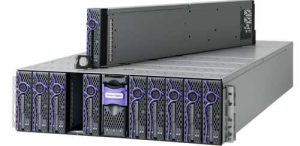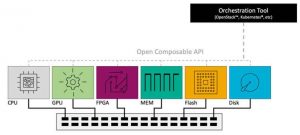Fabrics and New Data Infrastructure From Western Digital
Architectural approach to composable infrastructure known as OpenFlex
This is a Press Release edited by StorageNewsletter.com on March 13, 2020 at 2:13 pmBy Erik Ottem, senior director, product marketing, data center systems, Western Digital Corp.
New data infrastructure is coming.
Openflex composable infrastructure array

But what exactly is it and why do we need it? Well, first thing is all that data. Thinking of data infrastructure, you might think about the rise of unstructured data from our phones, cars, satellites and the wealth of other monitors, sensors and gizmos that spit out data. It wouldn’t be outlandish to think of data infrastructure as a database or application that helps you get useful information from all that data – getting value from all that data is where interesting things start to happen. Lastly, part of the data infrastructure might also be considered as data governance, data cleansing and data engineering (yes, it’s a thing). Or in other words, data is a complicated business.
What is driving the need for new data infrastructure?
Clearly, we have all kinds of data infrastructures already. But the rate of change in business is driving the need for new architectures. Businesses are changing faster than ever, and the stakes have never been higher to get your technological house in order. Studies have shown that businesses that can develop new business models return higher profits and are valued higher than companies that don’t (1). It gets worse, companies that cannot adapt quickly to use technology effectively have shorter lives (2).
The stakes have never been higher to get your technological house in order.
Rigid infrastructure can slow business change. If a business is planning a new business model, this will often entail a new way of collecting, processing and storing data. Your infrastructure needs to keep up. Delays give your competitors time to catch up with your great idea and rob you of the advantage. The old ways of planning, procuring, and deploying data center infrastructure are an unfitting model for a world driven by services and fast data. You need to be nimble. You need to be flexible. You need to be composable.
Your future is composable
Composable? By composable, I mean composable disaggregated infrastructure where the pieces of the data infrastructure you need can be assembled, and reassembled as needed. If you take your IT resources such as compute, memory, storage and networking and consider them as elastic building blocks, a composable disaggregated infrastructure can respond to emerging business needs on the fly, always delivering the optimal level of resources – higher or lower. This means being far more efficient with hardware resources, and data management.
Hello fabrics
Unlike a network which may restrict the connections possible among the attached elements, a data center ‘fabric’ enables any-to-any connections among elements. This flattened architecture and gets its name by the crisscross nature of the matrix of connections.
As we see below, the different resources can be plugged into a common data fabric to create the IT resources needed.
Figure 1. IT Resources on common data fabric
Click to enlarge
Putting it all together
The way this can work in a dynamic fashion is illustrated in figure 2 where these different IT resources can be managed by an orchestration layer to assemble only those resources required, and avoid the cost of those not needed.
This approach is very similar to what we’ve been accustomed to with the public cloud, yet it comes with all the benefits of on premises deployment – superior performance, lower latencies and utmost control over your data path and its cost. You can play nicely with the cloud, but never lose view of where exactly your data resides.
Meeting a rapidly changing business environment requires a dexterous type of architecture. Unlike hyperconverged infrastructure where building blocks are pre-configured, in a composable infrastructure these resources are deployed as needed with characteristics that match the workload.
No application too small, no AI too demanding
In the example below, you can see how the pool of generic resources can result in a number of very different specialized configurations:
Figure 2. Systems created by ‘composing’ the pools of resources
Click to enlarge
Here we see how resources are allocated to new system based on workload need.
For instance:
-
System #1 we have some CPU, GPU, flash memory and some memory to perform real-time analytics.
-
System #2 we have CPU, FPGA, flash, memory and disk resources for a more conventional workload.
-
System #3 we have CPU, memory and lots of disk for a backup workload.
-
Finally, System #4 demonstrates an FPGA based system with lots of memory and flash for a high performance specialized workload.
I think you see the concept.
Our take on things
Composable disaggregated infrastructure is just getting started. There are market-ready solutions being deployed in data centers today, as well as technologies that can be a stepping-stone on the path to fully composable architecture. Our architectural approach to composable infrastructure is known as OpenFlex.
OpenFlex architecture has the flexible and scalable characteristics you need to build a system to fits changing applications, projects and business needs. It is part of our larger thinking how new data infrastructure should look like. Not just composable, but also open and interoperable.
Our composable approach is built around a NVMe-oF data fabric that provides high-speed connectivity to high-performance flash devices. By leveraging our exclusive knowledge in Flash NAND along with our recent acquisition of Kazan Networks, we can deliver the highest performance density in the market. Yet it’s not just about devices. OpenFlex architecture supports a variety of technologies. It is an open architecture and an available API to integrate your pieces into the framework is open and published. We’re also ensuring that pieces from different vendors can operate seamlessly under a single environment. With our Open Composable Interoperability Lab initiative we are working with a broad ecosystem to make this a reality.
New data infrastructure
These are early days for open composable infrastructure, OpenFlex and new data infrastructure. If you are looking at a tech refresh, this would be a good time to look into OpenFlex. If you’re looking to take just one step forward, NVMe-oF solutions are the way to get started.
Business increasingly moves at the speed of infrastructure, so you need to keep your game competitive.
Resource:
More about OpenFlex
(1) Technology is changing how we view industry, value companies, and develop strategy
(2) 2018 Corporate Longevity Forecast: Creative Destruction is Accelerating
















 Subscribe to our free daily newsletter
Subscribe to our free daily newsletter

